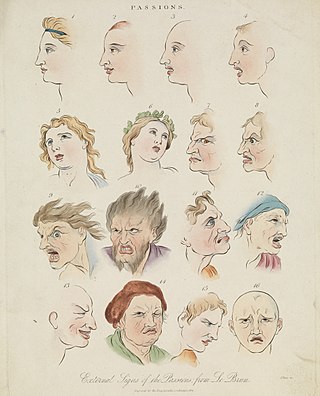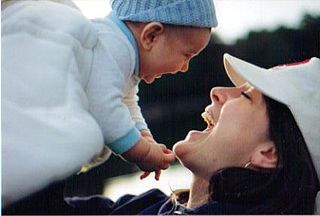
Aesthetics is the branch of philosophy concerned with the nature of beauty and the nature of taste; and functions as the philosophy of art. Aesthetics examines the philosophy of aesthetic value, which is determined by critical judgements of artistic taste; thus, the function of aesthetics is the "critical reflection on art, culture and nature".

Beauty is commonly described as a feature of objects that makes these objects pleasurable to perceive. Such objects include landscapes, sunsets, humans and works of art. Beauty, together with art and taste, is the main subject of aesthetics, one of the major branches of philosophy. As a positive aesthetic value, it is contrasted with ugliness as its negative counterpart.

Emotions are mental states brought on by neurophysiological changes, variously associated with thoughts, feelings, behavioral responses, and a degree of pleasure or displeasure. There is no scientific consensus on a definition. Emotions are often intertwined with mood, temperament, personality, disposition, or creativity.

Perception is the organization, identification, and interpretation of sensory information in order to represent and understand the presented information or environment. All perception involves signals that go through the nervous system, which in turn result from physical or chemical stimulation of the sensory system. Vision involves light striking the retina of the eye; smell is mediated by odor molecules; and hearing involves pressure waves.
Pleasure refers to experience that feels good, that involves the enjoyment of something. It contrasts with pain or suffering, which are forms of feeling bad. It is closely related to value, desire and action: humans and other conscious animals find pleasure enjoyable, positive or worthy of seeking. A great variety of activities may be experienced as pleasurable, like eating, having sex, listening to music or playing games. Pleasure is part of various other mental states such as ecstasy, euphoria and flow. Happiness and well-being are closely related to pleasure but not identical with it. There is no general agreement as to whether pleasure should be understood as a sensation, a quality of experiences, an attitude to experiences or otherwise. Pleasure plays a central role in the family of philosophical theories known as hedonism.
Experience refers to conscious events in general, more specifically to perceptions, or to the practical knowledge and familiarity that is produced by these processes. Understood as a conscious event in the widest sense, experience involves a subject to which various items are presented. In this sense, seeing a yellow bird on a branch presents the subject with the objects "bird" and "branch", the relation between them and the property "yellow". Unreal items may be included as well, which happens when experiencing hallucinations or dreams. When understood in a more restricted sense, only sensory consciousness counts as experience. In this sense, experience is usually identified with perception and contrasted with other types of conscious events, like thinking or imagining. In a slightly different sense, experience refers not to the conscious events themselves but to the practical knowledge and familiarity they produce. In this sense, it is important that direct perceptual contact with the external world is the source of knowledge. So an experienced hiker is someone who actually lived through many hikes, not someone who merely read many books about hiking. This is associated both with recurrent past acquaintance and the abilities learned through them.

Wishful thinking is the formation of beliefs based on what might be pleasing to imagine, rather than on evidence, rationality, or reality. It is a product of resolving conflicts between belief and desire. Methodologies to examine wishful thinking are diverse. Various disciplines and schools of thought examine related mechanisms such as neural circuitry, human cognition and emotion, types of bias, procrastination, motivation, optimism, attention and environment. This concept has been examined as a fallacy. It is related to the concept of wishful seeing.
The mere-exposure effect is a psychological phenomenon by which people tend to develop liking or disliking for things merely because they are familiar with them. In social psychology, this effect is sometimes called the familiarity principle. The effect has been demonstrated with many kinds of things, including words, Chinese characters, paintings, pictures of faces, geometric figures, and sounds. In studies of interpersonal attraction, the more often people see a person, the more pleasing and likeable they find that person.

Neuroesthetics is a relatively recent sub-discipline of applied aesthetics. Empirical aesthetics takes a scientific approach to the study of aesthetic experience of art, music, or any object that can give rise to aesthetic judgments. Neuroesthetics is a term coined by Semir Zeki in 1999 and received its formal definition in 2002 as the scientific study of the neural bases for the contemplation and creation of a work of art. Neuroesthetics uses neuroscience to explain and understand the aesthetic experiences at the neurological level. The topic attracts scholars from many disciplines including neuroscientists, art historians, artists, art therapists and psychologists.
Affective forecasting is the prediction of one's affect in the future. As a process that influences preferences, decisions, and behavior, affective forecasting is studied by both psychologists and economists, with broad applications.
The hedonic treadmill, also known as hedonic adaptation, is the observed tendency of humans to quickly return to a relatively stable level of happiness despite major positive or negative events or life changes.

Affect, in psychology, refers to the underlying experience of feeling, emotion, attachment, or mood. In psychology, "affect" refers to the experience of feeling or emotion. It encompasses a wide range of emotional states and can be positive or negative. Affect is a fundamental aspect of human experience and plays a central role in many psychological theories and studies. It can be understood as a combination of three components: emotion, mood, and affectivity. In psychology, the term "affect" is often used interchangeably with several related terms and concepts, though each term may have slightly different nuances. These terms encompass: emotion, feeling, mood, emotional state, sentiment, affective state, emotional response, affective reactivity, disposition. Researchers and psychologists may employ specific terms based on their focus and the context of their work.
The psychology of art is the scientific study of cognitive and emotional processes precipitated by the sensory perception of aesthetic artefacts, such as viewing a painting or touching a sculpture. It is an emerging multidisciplinary field of inquiry, closely related to the psychology of aesthetics, including neuroaesthetics.
Affect displays are the verbal and non-verbal displays of affect (emotion). These displays can be through facial expressions, gestures and body language, volume and tone of voice, laughing, crying, etc. Affect displays can be altered or faked so one may appear one way, when they feel another. Affect can be conscious or non-conscious and can be discreet or obvious. The display of positive emotions, such as smiling, laughing, etc., is termed "positive affect", while the displays of more negative emotions, such as crying and tense gestures, is respectively termed "negative affect".
Processing fluency is the ease with which information is processed. Perceptual fluency is the ease of processing stimuli based on manipulations to perceptual quality. Retrieval fluency is the ease with which information can be retrieved from memory.

Rolf Reber is professor of psychology at the University of Oslo.

The assimilation effect, assimilation bias or biased assimilation is a bias in evaluative judgments towards the position of a context stimulus, while contrast effects describe a negative correlation between a judgment and contextual information.
The rhyme-as-reason effect, or Eaton–Rosen phenomenon, is a cognitive bias whereupon a saying or aphorism is judged as more accurate or truthful when it is rewritten to rhyme.
In psychology of art, the relationship between art and emotion has newly been the subject of extensive study thanks to the intervention of esteemed art historian Alexander Nemerov. Emotional or aesthetic responses to art have previously been viewed as basic stimulus response, but new theories and research have suggested that these experiences are more complex and able to be studied experimentally. Emotional responses are often regarded as the keystone to experiencing art, and the creation of an emotional experience has been argued as the purpose of artistic expression. Research has shown that the neurological underpinnings of perceiving art differ from those used in standard object recognition. Instead, brain regions involved in the experience of emotion and goal setting show activation when viewing art.
Experimental aesthetics is a field of psychology founded by Gustav Theodor Fechner in the 19th century. According to Fechner, aesthetics is an experiential perception which is empirically comprehensible in light of the characteristics of the subject undergoing the experience and those of the object. Experimental aesthetics is the second oldest research area in psychology, psychophysics being the only field which is older. In his central work Introduction to Aesthetics Fechner describes his empirical approach extensively and in detail. Experimental aesthetics is characterized by a subject-based, inductive approach.








